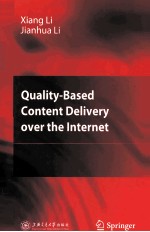

QUALITY-BASED CONTENT DELIVERY OVER THE INTERNETPDF电子书下载
- 电子书积分:8 积分如何计算积分?
- 作 者:XIANG LI JIANHUA LI
- 出 版 社:SPRINGER
- 出版年份:2011
- ISBN:731306716X
- 页数:139 页
1 Introduction 1
1.1 Background 1
1.2 Challenges 3
1.3 Research Topics 3
1.4 Focus of This Book 4
1.5 Book Outline 5
2 Related Work 7
2.1 New Challenges to Web Content Delivery 7
2.2 Overview of Active Network 8
2.3 Basic Technologies in Active Network 10
2.3.1 Basic Proxy Caching 11
2.3.2 Transcoding for Pervasive Internet Access 12
2.3.3 Adaptive Content Delivery 14
2.4 Adaptive Web Content Delivery Systems Built 23
2.4.1 IBM’s Transcoding Proxy 23
2.4.2 Berkeley’s Pythia and TranSend 24
2.4.3 Rice’s Puppeteer 24
2.5 Special-Purpose Proxies 25
2.5.1 Compression Proxy 25
2.5.2 WAP Gateway 26
2.5.3 Single Point Transform Server,ASP 26
2.5.4 Blocking and Filtering 26
2.6 Analysis of Existing Adaptive Content Delivery Frameworks and Systems 27
2.7 Summary 28
References 28
3 Chunk-Level Performance Study for Web Page Latency 37
3.1 Introduction 37
3.2 Basic Latency Dependence Model 39
3.3 Web Page Retrieval Latency 43
3.4 Experimental Study and Analysis 47
3.4.1 Experimental Environment 47
3.4.2 Web Page Latency Breakdown 48
3.4.3 Object Retrieval Parallelism 50
3.4.4 Definition Time and its Rescheduling 53
3.5 Discussion about Validity of Observed Results Under Different Environments 55
3.6 Conclusion 56
References 56
4 Accelerating Web Page Retrieval Through Reduction in Data Chunk Dependence 59
4.1 Introduction 59
4.2 Pre-requistes for Rescheduling of Embedded Object Retrieval 60
4.3 Intra-Page Rescheduling for Web Page Retrieval 63
4.3.1 Object Declaration Mechanism (OD) 63
4.3.2 History-Based Page Structure Table Mechanism (PST) 66
4.3.3 Analysis of Object Declaration and History-Based PST Mechanisms 69
4.4 Experimental Study 70
4.4.1 Potentials of Push-Forward and Parallelism Effect in Web Page Retrieval 72
4.4.2 Effect of Object Declaration Mechanism 74
4.4.3 Effect of History-Based Page Structure Table (PST) Mechanism 77
4.4.4 Effect of Integrated OD and PST Mechanism 79
4.5 Conclusion 82
References 82
5 Modes of Real-Time Content Transformation for Web Intermediaries in Active Network 85
5.1 Introduction 85
5.2 Basic Web Content Transformation Model 88
5.3 Modes of Content Transformation on Streaming Web Data 90
5.3.1 Byte-Streaming Transformation Mode 91
5.3.2 Whole-File Buffering Transformation Mode 92
5.3.3 Chunk-Streaming Transformation Mode 93
5.4 Discussion of the Impact of Transformation Mode on Web Page Latency 94
5.5 Experimental Study 96
5.5.1 Regrouping and Push-Backward Effects on Object Perceived Time 97
5.5.2 Regrouping and Push-Backward Effects on Page Retrieval Time 98
5.5.3 Regrouping and Push-Backward Effects in the Presence of Proxy Cache 99
5.6 Conclusion 101
References 101
6 System Framework for Web Content Adaptation and Intermediary Services:Design and Implementation 103
6.1 Introduction 103
6.2 Basic Proxy Cache 104
6.2.1 DataFlow Path of Proxy Cache 104
6.2.2 DataFlow Path in SQUID Proxy Cache 106
6.3 Four-Stage AXform Framework 108
6.3.1 Stage 1 of AXform Framework:Client Request Stage 109
6.3.2 Stage 2 of AXform Framework:Server Request Stage 111
6.3.3 Stage 3 of AXform Framework:Server Data Stage 114
6.3.4 Stage 4 of AXform Framework:Client Data Stage 117
6.3.5 Summary 119
6.4 System Implementation Considerations for AXform Framework 120
6.4.1 Handling of Working Space 120
6.4.2 Accessing Other System Resources 123
6.4.3 Client Information Collection 123
6.4.4 Server Information Collection 125
6.4.5 Environment Parameters Collection 126
6.4.6 Client Request Modification 127
6.4.7 HTTP Reply Header Modification 127
6.4.8 HTTP Body Modification 128
6.4.9 Cache Related Module 129
6.5 Conclusion 130
Reference 130
7 Conclusion 131
7.1 Conclusion of the Book 131
7.1.1 Performance Model 131
7.1.2 Improving the Delivery by Reducing the Object Dependence 132
7.1.3 Transformation Model 133
7.1.4 System Framework and Requirements 133
7.2 Future Research 134
7.2.1 APIs Definition 134
7.2.2 Unified Data Format 134
7.2.3 Data Integrity and Security 135
7.2.4 Protocol Design 135
Index 137
- 《等离子体重整乙醇制氢技术 英文》Jianhua Yan,Changming Du著 2018
- 《中国将称霸21世纪吗?》(美)弗格森 N. (Niall Ferguson),亨利·季辛吉(Dr.Henry Kissinger),李稻葵(David Daokui Li),Fareed Zakaria著;廖彦博译 2012
- 《移动智能》(加)Laurence T.Yang,(澳)Agustinus Borgy Waluyo,(日)Jianhua Ma,(澳)Ling Tan,(澳)Bala Srinivasan编著;卓力,张菁,李晓光,张新峰译 2014
- 《德克·希拉茨 认知社会语言学十讲》李福印;张炜炜,高远主编;Thomas Fuyin Li,Weiwei Zhang,Yuan Gao 2012
- 《Java 2 平台安全技术 结构、API设计和实现》(美)李宫(Li Gong)著;王运凯等译 2000
- 《CMOS电路设计·布局与仿真》(美)R. Jacob Baker,(美)Harry W. Li,(美)David E. Boyce著;陈中建主译 2006
- 《当代新药合成》(美)Jie-Jack Li等原著;施小新,秦川译 2005
- 《凡·高》Li Yanru译 2004
- 《跌法入门 松溪内家拳法精粹》吴兴贵传授 游民生整理 YOU MIN SHENG ZHENG LI 1990
- 《药物基因组学 寻求个性化治疗》(德)Julio Licinio,(德) Ma-Li Wong主编;蒋华良等译 2005
